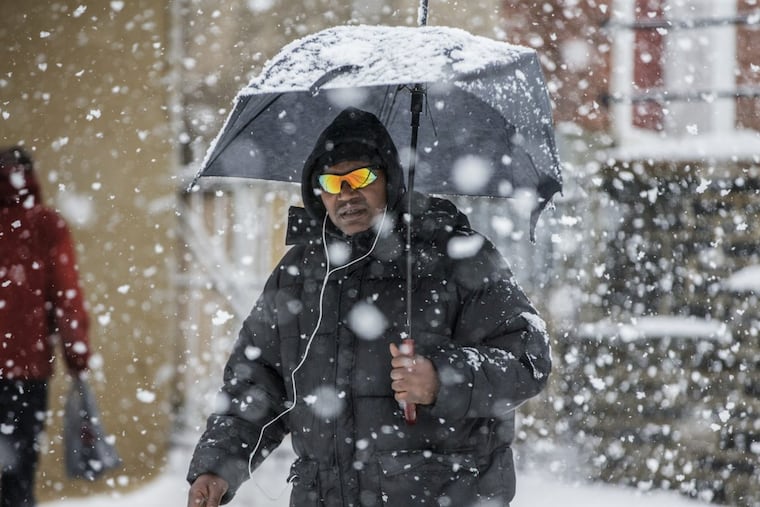'Thundersnow' put a charge into that coastal storm; power outages followed
Thundersnow gave Wednesday's coastal storm a jolt and probably contributed to those profoundly heavy snowfalls.

A veteran of the government's Storm Prediction Center in the heart of Tornado Alley, a national center for thunderstorm mayhem, Greg Carbin is well-acquainted with lightning.
So what the Philadelphia region and the rest of the Northeast experienced Wednesday got his attention. The powerful coastal storm, the second in six days, approached "bomb" intensity and literally packed quite a charge.
Sparks were flying with an outbreak of "thundersnow" — thunderstorms embedded in a winter storm. A lightning strike is believed to have set a Long Beach Island house on fire, and farther inland a woman was injured by another strike.
Thundersnow contributed to the incredibly heavy snowfall rates on a day when most of the accumulation fell within just a few blinding hours, and likely contributed to the second round of mega-power outages in six days.
Upward of a million utility customers on both sides of the river lost power in the two storms — among them Arlene Jarett, who lives on Great Springs Road in Lower Merion Township. She lost power as a result of the Friday surprise snowstorm amd finally got it back on Tuesday (an event she called "thrilling"), only to lose it again on Wednesday.
Even as tens of thousands remained without power on Thursday, meteorologists warned of the potential for another coastal storm to affect the region late Sunday into Monday. Then again, this is only Friday, a semi-eternity for a computer model.
Forecasters said the storm might remain far enough to the south and east to give us a pass this time. Meanwhile, temperatures for at least the next week are forecast to get no higher than the low- and mid-40s, an unpleasant sequel to one of the balmiest Februaries in the period of record.
A major pattern change that had its roots in the high atmosphere above the Arctic last month has resulted in a remarkable winter revival and one of the stormiest and most-disruptive March weeks on record.
Unlike Friday's ambush, the Wednesday storm did not qualify technically as a "bomb," said Carbin. But, it was nevertheless impressive. The criteria for "bomb" status is a 7/10th of an inch drop in barometric pressure over a 24-hour period.
But over a six-hour period Wednesday — when the storm was at its height — it intensified at a bomb rate, Carbin said.
The furious counterclockwise circulation of the coastal low imported a corridor of vapor-swollen air from the tropics, giving the storm a jolt of juice, generating up to 16 inches of snow in some areas, water-logged cotton-ball-size flakes that glued onto wires and branches, and thundersnow.
While infrequent, thundersnow has visited the region before. The effects parallel its warm-weather counterparts – lightning flashes, rumbles of thunder, rapidly falling precipitation – but physically thundersnow is quite different.
Thunderstorms are set off by rapidly rising air that produces the static needed for lightning. In summer, cloud tops can soar to 50,000 feet. In thundersnow, cloud heights are likely to be half that distance, Carbin said.
In the warm season, the storms are set off by air currents that tend to go straight up. In winter, the air is more likely to climb on an angle, or slantwise.
In summer, rumbles of thunder can be heard for 10 or 20 miles. In a snowstorm, the sound is muffled by the snow, Carbin said.
The winter and summer varieties have one thing in common. They can help knock out power.
Jarett has experienced many storm-related power outages in the past, so she knows her house is usually among the last that Peco reconnects.
The most tiresome part of the experience, she said, was having to call Peco's customer service line and listen to the same recorded message, telling her that the utility company was working hard to restore power. She knows from experience that if she tells the automated system she has a gas emergency she immediately gets a "real human being on the phone."
Mike Pugliese, whose home on Kings Road in Plymouth Meeting was left without power for six days after Friday's storm, had a similar complaint. He said he is weary of living in an area that seems to be one of the last clusters of houses restored after a storm. He argues that he pays the same rates as every other residential customer.
"I get that the biggest groups are going to get done first," he said of Peco's method of prioritizing outages for restoration. "The issue is, why do we pay the same amount if there is a different level of service?"
Staff writer Joseph A. Gambardello contributed to this article.